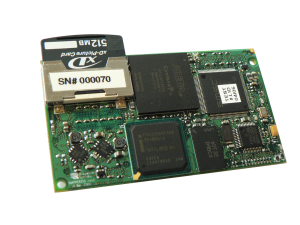Posted in Hardware design on May 31, 2010 by Daniel Keis
The XScale PXA255 processor has been around for about 7 years now and is coming to the end of its production life with no direct replacement available. Originally made by Intel but then moved to Marvell the PXA255's last time buy date has been pushed out over the last few years. Now it is drawing to an end with the last orders being accepted no later than the end of June and final delivery at the end of 2010.
http://en.wikipedia.org/wiki/XScale
The PXA255 is the heart of the Snapper 255 designed by Bluewater Systems back in 2004-05.
It has been used in a number of products since then, with notable success coming from the .
It's out with the old and in with the new Snappers that are on their way. So cast your lines and hook into the new Snappers to be announced !
Posted in Uncategorized on January 15, 2009 by Daniel Keis
In 2004 the first Snapper Single Board Computer Module was designed by Bluewater Systems. Snapper 255 is a powerful module which incorporates an FPGA, Ethernet, USB OTG, LCD with touchscreen, 64MB SDRAM and 512MB NAND Flash, all on a board smaller than a business card. Snapper 255 has been used in various designs since then but sadly is now coming closer to the end of its life. The Intel PXA255 microcontroller (now under the ownership of Marvell) that was originally used is unfortunately nearing the last time buy stage with no pin compatible replacement available. Marvell will sell stock as long as it is available, but the last time buy will be in the next six months. Grey market stock will still be available after this date but will prove to be more expensive. Bluewater will continue to sell Snapper 255s and liaise with existing customers to forecast future usage and ensure that sufficient stock is available. Snapper 255 is a great building block for embedded designs, proving to be a great tool to test product software before the final product is made. In saying this we have numerous other Snapper modules to take its place. 
Posted in New Development on December 02, 2008 by Daniel Keis
Bluewater Systems has developed the Big-Eye security camera system. Big-Eye uses a 3 Megapixel CMOS sensor and includes features like power-over-Ethernet, WiFi, IR motion sensing, day and night operation, solid state internal and external storage and even audio in/out. Our latest development with Big-Eye includes a tilt and pan enclosure which is rated for internal and external operation. Installation is as simple as connecting power-over-Ethernet to the camera and providing 24VAC to drive the tilt and pan motors. The tilt and pan operation is driven directly by the camera and can be operated via the GUI software, which can potentially be operated via the web. Below is a picture of Big-Eye in this tilt and pan enclosure. 
Posted in Hardware design on September 10, 2008 by Daniel Keis
For designs to become reality, they need to go through the prototype stage. Very few designs of high complexity will work the first time, hindsight is normally 20:20. Since most of the work performed by us utilises high-density miniature components on multi-layer boards, we have developed techniques to rework boards in such a fashion that we can test our changes before producing the next revision. Prototype designs often include provision for modification and adjustment through resistor fitment options. If this is not the case then PCB tracks need to be cut and wires placed to rewire the tracks. These are normally kept as short as possible and fitted in such a way that no components are covered, allowing further rework to be carried out if required. Solder mask can be scratched off to allow connection to otherwise normally non-accessible areas of the board. Chip legs can be lifted without removal of the pa to allow reconnection of both pin and pad if required. In extreme cases (very rare) we have replaced components with different footprints and pin outs and got these working before using them in the next revision. As these required modifications are not known before going to manufacture, some demanding but interesting modifications have been made without any fear of harming the prototypes.

Posted in Uncategorized on August 21, 2008 by Daniel Keis
Three engineering students were gathered together discussing the possible designers of the human body. One said, "It was a mechanical engineer. Just look at all the joints." Another said, "No, it was an electrical engineer. The nervous system has many thousands of electrical connections." The last one said, "Actually it was a civil engineer. Who else would run a toxic waste pipeline near a recreational area?"







